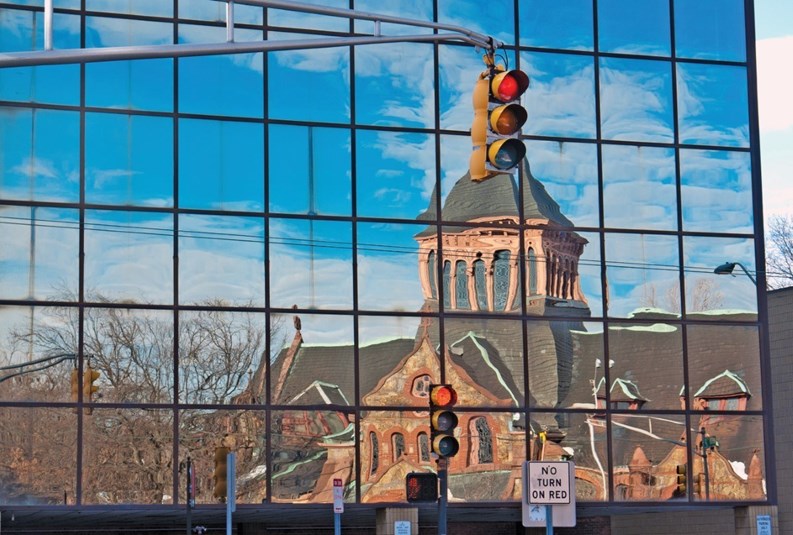Vibrant and bustling, Somerville has everything city dwellers love, want or need within walking distance of their own front doors. But with friendly neighborhoods and a strong sense of community pride, it’s as welcoming as any small town in the state of Massachusetts.
“We offer an urban experience with a small town feel,” said Mayor James Curtatone, a native and mayor for sevenyears. “We are stable and on a path of steady growth. Families, couples and singles want to live here.”
Somerville is located a few miles north of Boston on Route 28 and Interstate 93, with a stop on the Red Line offered by the Massachusetts Bay Transportation Authority (MBTA). Planned future expansion of the Greenand Orange lines hold promise for easier direct access into the city.
Its 78,000 residents live in a compact4.1 square miles, making Somerville the most densely populated municipality in New England. Yet it rarely feels crowded, just neighborly.
“It is an attractive urban setting, but all on a human scale, so that no place is overpowering and each place has its own personality,” said Stephen Mackey, president of the Somerville Chamber of Commerce.
Somerville is home to many immigrants, including long-time, blue collar Irish-American, Italian-American and Portuguese-American families throughout the city. Newer immigrants from Brazil, Haiti, El Salvador, South Korea, India and Nepal add to its rich ethnicity. Over 50 languages are spoken here.
Many artists call Somerville home as well, making the city second only to New York in terms of the number of resident artists per square mile. Somerville is in the middle of the so-called “brain power triangle” of nearby Tufts and Harvard universities and the Massachusetts Institute of Technology. Tufts straddles the Somerville/Medford city line and Harvard and MIT are a few Red Line T stops away in nearby Cambridge.
With its proximity to so many universities, many notables have calledSomerville home, including President Barack Obama, who lived here while he attended nearby Harvard Law School from 1988 to 1991.
Hip to Be Square
The city’s lively squares – nearly 20 of them – serve as social and commercial centers and attract people to Somerville.
“Our neighborhood squares are a big part of Somerville’s charm,” said Curtatone. “They’re safe, clean, vibrant, funky and unique. Each is different, distinct, with its own special amenities.”
The squares developed as small commercial districts, becoming more affluent and desirable as trolley lines came in, said Rob May, the city’s director of economic development andhistoric planning and preservation.
Davis Square, one of the largest and close to Tufts, is home to studentsand young professionals who love its lively coffee houses, vintage stores and independent retailers.
“It’s a great example of a mixed use business sector. You can go bowling, have dinner, enjoy drinks, watch streetperformers or get an ice cream in vibrant Davis Square,” said Mackey.
Union Square is a night life, shopping and art destination hub. Only a short distance from Harvard Square in Cambridge, Union Square features many locally-owned restaurants, neighborhood stores and bars –many of these Portuguese or Brazilian. And Assembly Square is the site of major new development, including a new IKEA store, over one million square feet of new research, development and retail space, 2,100 new condos slated for construction, and a new MBTA Orange Line stop.
“It’s one of the largest mixed use developments on the East Coast,” saidRonald Bonney, Jr., the Chamber of Commerce board chairman. “New roadways are under construction now, IKEA will be completed by 2012-2013 and the rest will roll out over the next few years.”
A Historic Past
Somerville was incorporated into a separate town in 1842, which separatedit from Charlestown. According to Somerville Historical Society research, the name was a “purely fanciful selection” and not associated with “some noted personage.”
Somerville is linked to the AmericanRevolution, notably in events at the Old Powder House and on Prospect Hill.
The Old Powder House, built in 1703 or 1704 as a mill and granary, became a storage place for the colonists’ gunpowder and small arms. In September, 1774, with Boston under British occupation, British General Thomas Gage ordered his soldiers to raid the powder house, stealing guns and ammunition. Historians consider the raid one of the first hostile moves leading up to the start of the Revolu-tionary War in April 1775.
“If it weren’t for the Powder House raid, the Battle of Lexington and Concord might not have happened,” said May.
The city preserves the Old Powder House as an historic landmark, locatedin Nathan Tufts Park on the grounds of Tufts University.
The British controlled Prospect Hill during the 11-month long siege of Boston in 1775-1776. Its prominent location gave them a key vantage point to observe the surrounding countryside and movements of the colonists.
Then, on January 1, 1776, General George Washington ordered General Israel Putnam to hoist the first flag of the United Colonies from the summit of Prospect Hill.
“As the banner with its thirteen stripes, alternating red and white, floated to the breeze, it was greeted with cheers and a salute of thirteen guns,” reports Haskell’s Historical Guide to Somerville, Massachusetts, a local history volume. Following the evacuation of Boston, the flag flew over a Boston harbor fort that the British had vacated.
Brawn and Brains
From its rural beginnings, Somervillebecame a part of the Industrial Revo-lution, which had its start in Massa-chusetts. In the early 1800s, traffic on the historic Middlesex Canal went through East Somerville on its way from the mouth of the Charles River in Boston to the mills in Lowell.
With the railroad’s arrival in the 1830s, the canal died out. But Somer-villeplayed its part in the industrial fervor of the time, with several large brick manufacturing plants located in town.
But it wasn’t all industry. East Somerville, on the banks of the MysticRiver, was also a popular summer resort for Bostonians in the 1800s.
“They built large homes as getaway escapes and many still remain with historic designation today,” said May, whose office works with people seeking to preserve the old homes and save a part of Somerville’s history.
Somerville’s industrial past leaves one sweet legacy for kids of all ages – Marshmallow Fluff. Inventor Archibald Query created the gooey concoction in 1917 in his Union Square lab. Fluff lives on here each September, when fans celebrate with the “What the Fluff Festival,” a day of games, theater, music, cooking and “Fluffernutter” sandwichesfor all.
In its recent past, Somerville was known as a blue collar city, with residents working in the trades. Today it has evolved into a broad-based businesscommunity with jobs as diverse as its population.
“It’s an interesting community, with a cross section of businesses,” said Mackey. “You’ll find everything from environmental technology companies to cobblers working here.”
And with its proximity to major universities, Somerville has one of the largest per capita populations of people with higher education degrees in the state. “We have a highly trained, well-educated work force here,” said Bonney.
Condo Boom
Somerville experienced dramatic gentrification – beginning with the MBTA’s Red Line extension through the city in 1985 –especially between Harvard and Tufts universities and centering around Davis Square.
Residential property values quadrupled from 1991 to 2003 and the stockof rental units decreased as lucrative condo conversions became commonplace.
Today, Somerville still has many two and three-family homes, but it is also a city of condominiums.
“Our typical buyers are first-time home buyers, single or couples without kids, buying a condo as a starter home,” said Thalia Tringo of Hammond Real Estate. “We are also seeing downsizers from the suburbs in their late-40s to their mid-60s, who are used to doing renovations and want to move back into the city.”
“It’s a fantastic community with an engaged population and a fun place to live,” Tringo noted. “People want to stay here and are moving from two-bedroom condos to single family homes. There are well-educated people living here who are happy with the schools and want to stay to raise families.”
Current condo prices range from $200,000 for units without easy accessto public transportation, restaurants and shopping to $700,000 up to $1 million for units close to the desirable squares and with interesting architectural features.
Assistant assessor Linda Swartz said that there are currently 4,138 residential condominium units in Somerville. Other housing includes 2,358 single-family homes and 5,232 two-family homes. From January 1, 2009 to June 30, 2010, there were 518 qualified sales of condominiums, ranging from $145,000 to $893,000.
A City on the Move
Somerville’s residents are justifiably proud of their community, which was designated an All America City in 2009 by the National Civic League. It marked its second such award and recognized the strong commitment by its citizens to work to tackle community-wide challenges and achieve positive results.
“I moved 1,000 miles from Chicagoto be a part of Somerville,” said May. “The access to Boston’s downtown and Logan Airport are unparalleled. You can get to Fenway Park and major museums in a heartbeat and it has amazing access to its universities and nightlife. It’s a great place to live and work.”
The mayor agrees.
“We are a city on the move: cleaner, leaner and greener. It’s a place for all, from empty-nesters to students to families and young professionals. We strive to be a fantastic city and offer everything you’d want –except for half-acre home lots,” said Curtatone with a smile.
Nancye Tuttle is a freelance writer who lives in Massachusetts.







Leave a Comment